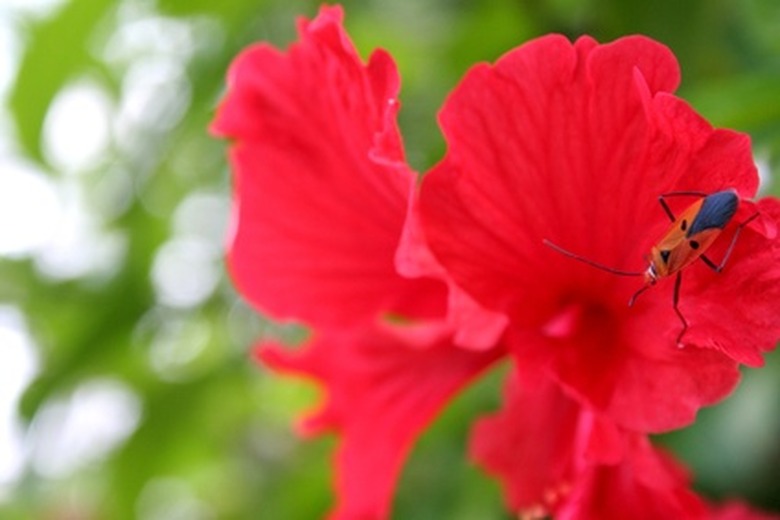How Often Do You Water A Hibiscus Plant?
The hibiscus — a tropical perennial plant native to eastern Asia — features attractive dark-green foliage and showy five-petaled blooms. Tropical hibiscus is often used in ornamental plantings in tropical and subtropical climates; its intolerance of frost requires that it be grown indoors in cooler locales.
The hibiscus — a tropical perennial plant native to eastern Asia — features attractive dark-green foliage and showy five-petaled blooms. Tropical hibiscus is often used in ornamental plantings in tropical and subtropical climates; its intolerance of frost requires that it be grown indoors in cooler locales. Fortunately, hibiscus adapts well to life as a houseplant.
Features
The hibiscus — botanically known as Hibiscus rosa-sinensis and also called the Chinese hibiscus and the China rose — displays blooms in a range of colors from white through salmon-pink to blazing red. True blue, however, is absent; Houston Hibiscus notes that hibiscus lacks the genes for it. Depending on the cultivar, hibiscus blooms can be single or double and can reach diameters of a foot across. Well-tended hibiscus plants are long-lived; Hibiscus Care notes that container-grown hibiscus can live for over 40 years.
- The hibiscus — a tropical perennial plant native to eastern Asia — features attractive dark-green foliage and showy five-petaled blooms.
- Well-tended hibiscus plants are long-lived; Hibiscus Care notes that container-grown hibiscus can live for over 40 years.
Requirements
Hibiscus are light-loving plants that need a few hours of direct sunlight daily; a south- or west-facing window is ideal, but make sure there are no drafts. Temperatures of 60 to 90 degrees Fahrenheit are well tolerated. Use a good-quality, well-drained potting soil; soil of too fine a consistency can compact in the pots and affect root aeration. Prune your hibiscus August through October by cutting back one-third of the main branches and removing weak growth, dead leaves, broken shoots and branches growing sideways. Hibiscus are heavy feeders during the growing months. From March through October, use a water-soluble formula weekly. To promote blossoming, use a fertilizer low in phosphorous; a 20N-5P-20K formulation is a good choice. Houston Hibiscus notes that the formula should also contain minor elements such as iron, copper and manganese.
- Hibiscus are light-loving plants that need a few hours of direct sunlight daily; a south- or west-facing window is ideal, but make sure there are no drafts.
Watering Specifics
Hibiscus require generous amounts of water in the growing season. In warm weather, many hibiscus enthusiasts advise daily watering, but this is a general rule of thumb. Observe your hibiscus closely for signs of under- or over-watering. During the winter, hibiscus require less water. Allow the soil to dry out slightly between waterings, then water lavishly, irrigating until water runs out the holes in the bottom of the container. To avoid root rot — to which hibiscus are susceptible — empty excess water from the saucer after half an hour. Avoid using cold water; tepid water — between 95 and 102 degrees — is more in keeping with the plant's tropical heritage. Hibiscus prefer water that is slightly acid; a pH of between 5.5 to 6.5 is ideal. If your water is very alkaline, Bachman's Floral Gifts and Garden advises adding 1 tbsp. of vinegar to each gallon. Hibiscus plants require not only ample water but adequate humidity as well. Using a spray mister with tepid water several times a week can supply needed moisture, as well as keeping down spider mites, a common pest of indoor hibiscus.
- Hibiscus require generous amounts of water in the growing season.
- To avoid root rot — to which hibiscus are susceptible — empty excess water from the saucer after half an hour.
Troubleshooting
Vibrant green foliage and profuse, colorful blossoms are indications of a properly watered plant. Yellow leaves may indicate under-watering; leaf wilting can indicate either insufficient irrigation or too much. You should periodically tip the plant and check the root ball; roots should be white to tan in color, flexible and plump. Dark or rotted-looking roots are evidence of over-watering. Trim them off and water less. Periodically, tip the plant and check the underside immediately after you have watered; the entire root ball should be wet.
